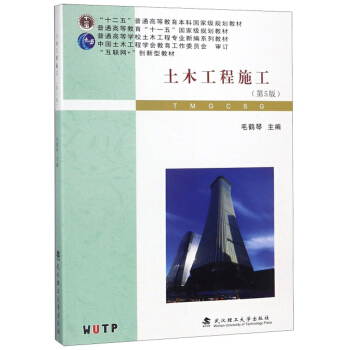环境化学(Chemistry of the Environment)(弓爱君)
定价:¥46.00
作者: 弓爱君
出版时间:2016年1月
出版社:化学工业出版社
- 化学工业出版社
- 9787122248992
- 88016
- 2016年1月
- 本科环境
- 本科
内容简介
This book includes five chapters,including Introduction,Atmosphere Environmental Chemistry,Water Environmental Chemistry,Soil Environmental Chemistry and Disasters and Environmental ProtectionThis book focused on atmosphere,water and biosphere,systematically illustrates the behavior of pollutants,the techniques and theories of easing and removing themThe section of biosphere combines the atmosphere,water and soil,thus it is not an independent chapterDisasters and environmental protection are specifically included in the chapter 5 for the sake of enhancing the environmental awareness of modern constructors
In order to improving the teaching effect,there are key points in every chapter and questions to be considered at the endMeanwhile,the teaching board has already published an exercise book Environmental Learning and Practicing Collection for bilingual teaching
The book can be used as the bilingual teaching material of Environmental Chemistry courses for undergraduates in environment,chemistry and biology majorsIt can also be used as a reference book for postgraduates in related majors and environmentalists
本书共五章,包括绪论、大气环境化学、水环境化学、土壤环境化学、灾害与环境保护。本书以大气、水、土壤三大圈层为主线,系统阐述了污染物的行为特征、减缓或消除污染的方法和原理。生物圈层的内容融入大气、水和土壤圈层,没有单独立章。为了增强新世纪建设者的环境意识,特将灾害与环境保护纳入本书的第五章。
为了提高本书的教学效果,每章正文开始前编有“本章要点”,每章末尾配有思考题。同时,我们教学组已经出版了与本教材配套的《环境化学习题集》(双语教学用)。
本书可作为高等学校环境、化学、生物等专业本科生的《环境化学》(双语)课程教材,也可作为相关专业研究生及环境工作者的参考书。
In order to improving the teaching effect,there are key points in every chapter and questions to be considered at the endMeanwhile,the teaching board has already published an exercise book Environmental Learning and Practicing Collection for bilingual teaching
The book can be used as the bilingual teaching material of Environmental Chemistry courses for undergraduates in environment,chemistry and biology majorsIt can also be used as a reference book for postgraduates in related majors and environmentalists
本书共五章,包括绪论、大气环境化学、水环境化学、土壤环境化学、灾害与环境保护。本书以大气、水、土壤三大圈层为主线,系统阐述了污染物的行为特征、减缓或消除污染的方法和原理。生物圈层的内容融入大气、水和土壤圈层,没有单独立章。为了增强新世纪建设者的环境意识,特将灾害与环境保护纳入本书的第五章。
为了提高本书的教学效果,每章正文开始前编有“本章要点”,每章末尾配有思考题。同时,我们教学组已经出版了与本教材配套的《环境化学习题集》(双语教学用)。
本书可作为高等学校环境、化学、生物等专业本科生的《环境化学》(双语)课程教材,也可作为相关专业研究生及环境工作者的参考书。
目录
Chapter 1 Introduction1Section 1 What is Environmental Chemistry?11.Definition of Environmental Chemistry12.Classification of Environmental Chemistry13.Research Content of Environmental Chemistry24.Characteristics of Environmental Chemistry25.Development of Environmental Chemistry3Section 2 Environmental Pollution Events41.Environmental Pollution42.Eight public nuisances in the world43.Recent years’ the world famous public nuisance6Section 3 The Process of People’s Awareness of Environmental Issues81.The main environmental problems82.People’s awareness of environmental problem83.The solution to the key problems of the prevention and control of environmental pollution in China9Questions11Chapter 2 Atmosphere Environmental Chemistry12Section 1 Evolution of Earth Atmosphere12Section 2 The Vertical Structure and Distribution Characteristics of the Atmosphere141.Troposphere142.Stratosphere163.Mesosphere164.Thermosphere165.Exosphere16Section 3 Radiation Balance of the Earth161.The relations between the maximum of radiation wavelength and the temperature162.Absorption of solar radiation by atmospheric composition183.The thermal equilibrium of the earth184.Greenhouse Effect20Section 4 Tropospheric Atmospheric Chemistry221.The classification of atmospheric composition222.The sources,sinks of atmospheric composition and the atmosphere cycle233.The important light absorption materials in the atmosphere244.Atmospheric radical255.Tropospheric photochemical processes Clean Air27Section 5 Photochemical Smog281.The emergence of photochemical smog282.Daily changing law of photochemical smog283.Forming mechanism of photochemical smog284.The influencing factors and the peugeot of formation of photochemical smog295.PAN306.Photochemical smog pollution control30Section 6 Acid Deposition Chemistry301.The definition of acid rain and precipitation acidification process312.The harm caused by acid rain pollution363.Present situation and the control countermeasures of acid rain pollution in China37Section 7 Urban Air Quality Problems421.Status quo and development trend of China’s urban air quality422.Urban air quality daily43Questions45Chapter 3 Water Environmental Chemistry46Section 1 General Situation of Natural Water461.Water resources and utilization462.Water distribution on the earth463.Water cycle474.The conformations of natural water48Section 2 Water Body Pollution521.Water body pollution and selfpurification522.Pollutants in water543.The movement procedure of pollutants after discharging into the water584.Water pollution effect on human body59Section 3 Water Environment Chemistry of Organic Pollution601.Parameter of organic pollution602.Degradation of some organic pollutants in water64Section 4 Method for Wastewater Treatment691.First treatment for wastewater692.Secondary treatment for wastewater703.Tertiary treatment for wastewater704.Typical process of municipal wastewater treatment71Questions72 Chapter 4 Soil Environmental Chemistry73Section 1 Formation of Soil731.The essence of soil formation732. Natural factors for the formation of soil753.Human role in formation of soil77Section 2 Soil Composition771.Soil mineral782.Soil organic matter803.Soil solution804.Soil air81Section 3 The Basic Property of Soil811.The physical property of soil822. The colloidal property of soil823. The composition and chelate of soil854. The redox properties of soil865. Acid and alkali of soil876. The biological properties of the soil877. Selfpurification of soil88Section 4 Soil Pollution881. Soil pollution source892. The main pollution of soil89Section 5 Soil Pollution Control1011. Control and eliminate soil pollution source1012. Soil improvement and repair1043. Development of green food,Promotion for human health105Questions106Chapter 5 Disasters And Environmental Protection107Section 1 Geological Hazard1071. Earthquake1072. Volcano1093. Debris Flow110Section 2 Weather Disasters1121.El Nino1122. Hurricane113Section 3 Biodiversity and Lethal Pests1151.Biodiversity1152.Lethal pests118Section 4 Food Safety1251.Food safety and food quality1252.Food safety incidents1263.Analysis about the causes of food safety incidents1274.Solutions128Section 5 Environmental Protection1291.Urbanization has brought many environmental problems,so environmental situation of our country is very serious1292.The underlying causes of environmental pollution1303.Actively explore new environmental method1324.Strictly control PM2.5 pollution1325.Environmental Protection “Contribution in the contemporary” and “Benefit future generations”1336.The development trend of China’s Environmental Management Policy in the next 10 years134Questions135References136第一章绪论137第一节什么是环境化学137一、环境化学的定义137二、环境化学的分类137三、环境化学的研究内容137四、环境化学的特点137五、环境化学的发展方向138第二节环境污染事件139一、环境污染139二、世界上曾发生过的八大公害事件139三、近年来世界瞩目的公害事件141第三节人们对环境问题的认识过程142一、面临的主要环境问题142二、人们对环境问题的认识142三、我国环境污染防治面临的主要问题及解决方案143思考题144第二章大气环境化学145第一节地球大气的演化145第二节大气层的垂直结构分布特征146一、对流层147二、平流层148三、中间层148四、热层148五、逃逸层148第三节地球的辐射平衡148一、物体的最大辐射波长与温度的关系148二、大气成分对太阳辐射的吸收149三、地球的热平衡150四、温室效应151第四节对流层大气化学反应153一、大气组成的分类153二、大气组分的源、汇和气体循环154三、大气中重要的光吸收物质155四、大气中的自由基156五、对流层清洁大气的光化学过程157第五节光化学烟雾158一、光化学烟雾的出现158二、光化学烟雾的日变化规律158三、光化学烟雾的形成机制158四、光化学烟雾形成的影响因素与标志159五、PAN159六、光化学烟雾污染的控制159第六节酸沉降化学160一、酸雨的定义及降水的酸化过程160二、酸雨污染造成的危害164三、我国酸雨的污染现状及控制对策164第七节城市空气质量问题167一、我国城市空气质量的现状和发展趋势167二、城市空气质量日报169思考题170第三章水环境化学171第一节天然水概况171一、水资源和利用171二、地球上水的分布171三、水循环172四、天然水的组成172第二节水体污染176一、水体污染与自净176二、水体中的污染物177三、污染物进入水体后的运动过程180四、水体污染对人体健康的影响181第三节有机物污染的水环境化学182一、有机污染程度的指标182二、水体中某些有机污染物的降解184第四节废水处理方法187一、废水的一级处理188二、废水的二级处理188三、废水的三级处理189四、城市废水处理的典型流程189思考题191第四章土壤环境化学192第一节土壤形成192一、土壤形成的实质192二、土壤形成的自然因素193三、土壤形成的人为作用194第二节土壤的组成194一、土壤矿物质195二、土壤有机质197三、土壤溶液197四、土壤空气198第三节土壤的基本性质198一、土壤的物理性质198二、土壤的胶体性质199三、土壤的配合和螯合作用200四、土壤的氧化还原性质201五、土壤的酸碱性202六、土壤的生物学性质202七、土壤的自净作用202第四节土壤污染203一、土壤污染源203二、土壤的主要污染物204第五节土壤污染防治211一、控制和消除土壤污染源212二、土壤改良与修复214三、发展绿色食品,促进人类健康215思考题215第五章灾害与环境保护216第一节地质灾害216一、地震216二、火山217三、泥石流218第二节天气灾害219一、厄尔尼诺219二、飓风220第三节生物多样性及致命害虫221一、生物多样性221二、致命害虫223第四节食品安全228一、食品安全与食品质量228二、食品安全事件229三、食品安全事件原因分析230四、解决方案230第五节环境保护231一、城市化相伴带来诸多环境问题,当前我国环境形势依然严峻231二、环境污染背后的深层原因232三、积极探索环保新道路233四、严格治理PM2.5污染233五、环境保护“功在当代”、“利在千秋”234六、未来十年我国环境管理政策发展趋势235思考题235参考文献236















